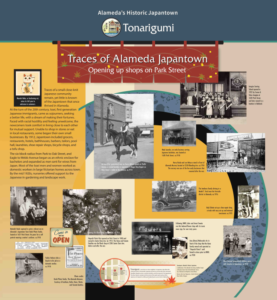Honoring Alameda’s Lost Japantown

Alameda once had a thriving Japantown, but few Alamedans know of its history and the story of its residents.
At the turn of the 20th century, the Issei, first generation Japanese immigrants, came to Alameda as “sojourners”, seeking a better life, with a dream of making their fortunes. The new immigrants settled in a Japantown community roughly bounded by Park Street, Santa Clara Avenue, Walnut Street and the Oakland Estuary.
In response to the growing number of Japanese immigrants and local restrictions on where they could eat, shop, or get a haircut, Japanese-run businesses began to open on Park Street, mostly between Santa Clara Ave and Pacific Ave. By 1912, Alameda Japantown consisted of barbers, bathhouses, hotels, restaurants, grocers, tofu shops, laundries, bicycle shops, a doctor, a tailor, and shoe repair shops. Local businesses increased in the mid-1920s with nurseries and floral shops to support the Japanese in gardening and landscape work. By the 1930s Alameda’s Japantown was flourishing.
However, the journey for the Issei was filled with many hardships. They faced anti-immigration laws in the 1920s, increased animosity toward Japanese in the 1930s, and the relocation and incarceration of persons of Japanese ancestry from 1942 to the end of World War II.
Despite the erasure of Alameda Japantown, the Japanese Methodist Church South and the Buddhist Temple remained opened as hostels in 1946, offering hope for the returning Japanese, and a promise to revitalize the tonarigumi, neighborhood cohesiveness, that exists today.
With the existence of Alameda’s Japantown remaining hidden from public memory, a new partnership between the City of Alameda, Buena Vista United Methodist Church, and the Buddhist Temple of Alameda aims to raise awareness and reclaim the memories of the past, and to honor the strength and resilience of a community. The City of Alameda’s Tonarigumi Historic Marker project includes the installation of four markers that are being created to share a forgotten history of Alameda’s Japantown and impart a lesson from the past, to embrace diversity and advocate civil liberties for all people.
Each of the four markers present a different aspect of the Japanese American community in Alameda’s Japantown. The first marker was installed on November 17, 2022 and the other three will be installed over the next few months:

• “Traces of Alameda Japantown” at the Alameda Marketplace (installed on 11/17/2022)
• “Life that Connects Us All” at the Buddhist Temple of Alameda
• “Becoming a Japantown” at the City of Alameda Free Library
• “A Beacon of Light” at Buena Vista Methodist United Church
Map credit: Japantown Atlas
Learn more about Alameda’s Japantown history: Alameda Sun, July 2020
Learn more about the Tonarigumi Historic Marker project: Alameda Sun, November 2022
